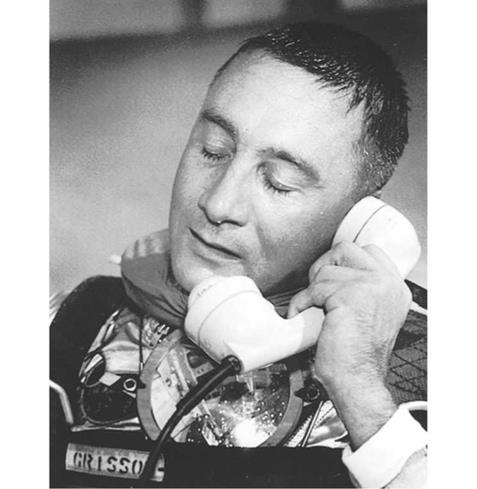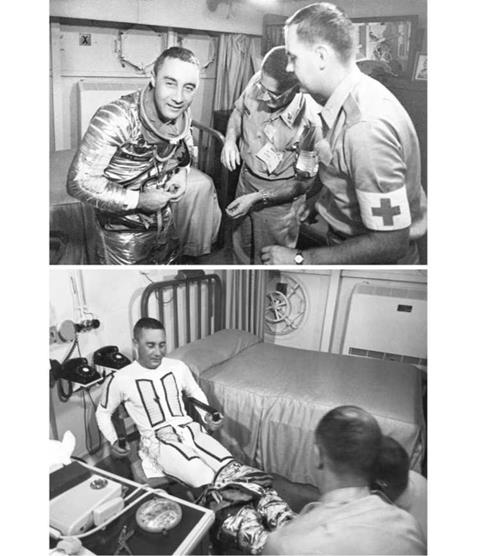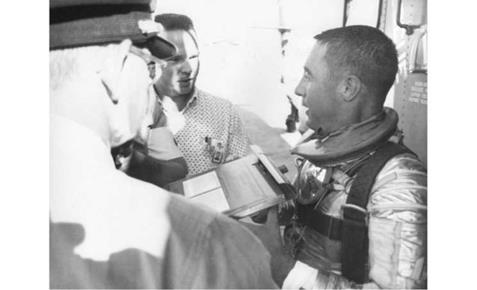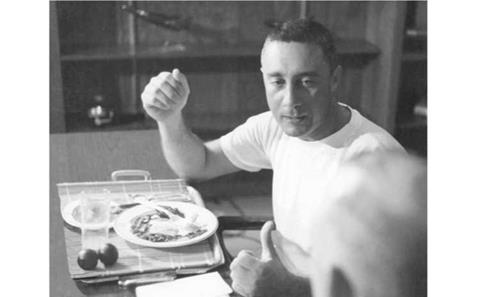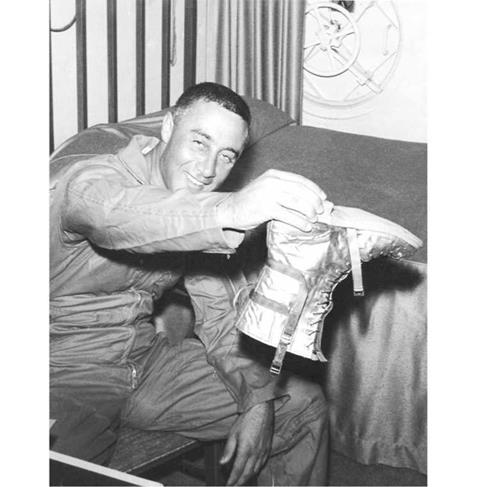DEAN CONGER RECALLS
Sometime in 1960 the editor of the National Geographic magazine offered to lend a photographer to NASA to document the Mercury program. Dean Conger had a longtime interest in aviation and had already documented the X-15 program, so he was selected. In May 1961 he took many of the iconic shots of Alan Shepard that graced the National Geographic, newspapers, and other publications. He was also onboard the USS Randolph to photograph the recovery of Gus Grissom.
“It was an exciting time,” Conger related, looking back. “On the ship I had very little conversation myself with Grissom. I was there to observe and document. Over the course of many months I had met all of the doctors and debriefers who would be in the sick bay; in fact, we became quite friendly and they knew I wouldn’t take any compromising pictures.”
He did, however, mention that he had two particularly unforgettable memories of photographing Grissom. “One of the first things that happened when he got on the carrier was a phone call from the President… that was the last thing he wanted right then. He still has his space suit on… probably full of sea water. I don’t know how it came about, but I also took a picture of him turning his boot upside-down, pouring water out. It was widely published at the time. There were other shots of him after he got cleaned up and the doctors had checked him out. By the time he was ready to fly to Grand Bahama Island he was all smiles.”30
After the nation’s newest hero had been assisted in stripping off his water-filled space suit in the captain’s cabin, and had dried off, a Navy officer handed Grissom his helmet, which had been retrieved from the Atlantic. To Grissom’s astonishment the officer told him a destroyer crew had plucked it from the sea next to a circling ten-foot shark. He was also presented with a bright orange Navy flight suit to wear. The decorated Air Force test pilot gave a wry smile as he cast his eyes over the suit and could not resist making the wisecrack remark, “I’ve been trying to get one of these things for years!”
Earlier, when Grissom had stepped down from the rescue helicopter, he had seen a familiar face standing alongside the two doctors. Senior NASA Space Task Group representative Charles Tynan was onboard as the Recovery Team Leader, just as he had been on the USS Lake Champlain for the recovery of Alan Shepard two months earlier. And just as on the Shepard recovery, Tynan was wearing his “lucky” yellow patterned shirt.
As Tynan recalled for the author, “I met him at the helicopter with the doctors immediately after the helicopter landed on the carrier, and later approached him in the wardroom. Although we were not supposed to talk with Shepard after his flight, since Grissom’s capsule sank I was instructed from MCC [Mercury Control Center] to talk with Gus and see if I could find out why the hatch had blown prematurely. I remember approaching Gus, dressed in a white terry cloth bathrobe, starting to eat breakfast. When I approached, he was spitting out some bad prunes. He cursed and said ‘Nothing has gone right today’ because the prunes he was starting to eat were no good. Grissom was upset about the capsule sinking but he was adamant about any hint that he blew the hatch, so I didn’t learn much about the blown hatch. He didn’t want to talk about it. He claimed then, and later, that he did not blow the hatch.”31
|
Dean Conger’s photo shows the dejected and sodden astronaut taking a phone call from his President. (Photo: Dean Conger/NASA) |
During his shipboard debriefing, Grissom paid homage to a life-saving device designed by a fellow astronaut. “Before I end this debriefing,” he recorded, “I want to say that I’ll ever be grateful to Wally [Schirra] for the work he did on the neck dam. If I hadn’t had the neck dam up, I think I would have drowned before anyone could have gotten to me. I just can’t get over the fact that the neck dam is what saved me today… So, of course, that’s another recommendation: put the neck dam up right away.
“Also, I would recommend that you get the Mylar raft out [of the survival pack] and keep it in your lap before egress even though the chopper is there. I think I was just a little bit over-confident this morning. I saw the choppers were there and so I thought everything was going to be okay. And I almost didn’t put the neck dam up… I think
|
Having spoken to the President, Grissom could finally shed his waterlogged space suit with a little assistance. (Photos: Dean Conger/NASA) |
we should plan for a few more emergencies along the recovery line and follow procedures exactly as we planned, not get hurried and not get over-confident, either.”32 There is little doubt that Gus Grissom would have been in dire trouble had he not already been unbuckled with his neck dam rolled up when the hatch blew, giving him barely seconds to make his hurried way out of the sinking spacecraft. The other saving grace was that he was the smallest of the Mercury astronauts. As space historian Rick
|
|
NASA’s Charles Tynan (colored shirt) was on hand to greet the nation’s newest astronaut hero. (Photo: NASA)
|
|
Grissom enjoys a hot breakfast despite the presence of some ‘suspect’ prunes. (Photo: Dean Conger/NASA)
|
Feeling better after a dry change of clothes and breakfast, Grissom laughs as he pours sea water from one of his space suit boots. (Photo: Dean Conger/NASA) |
Boos commented, “When you consider that they were shoehorned in, the angle of the instrument panel relative to the hatch opening, the limited amount of space to be inserted in or to exit from, it was a wonder that he ever was able to exit, especially considering the sink time.”33











